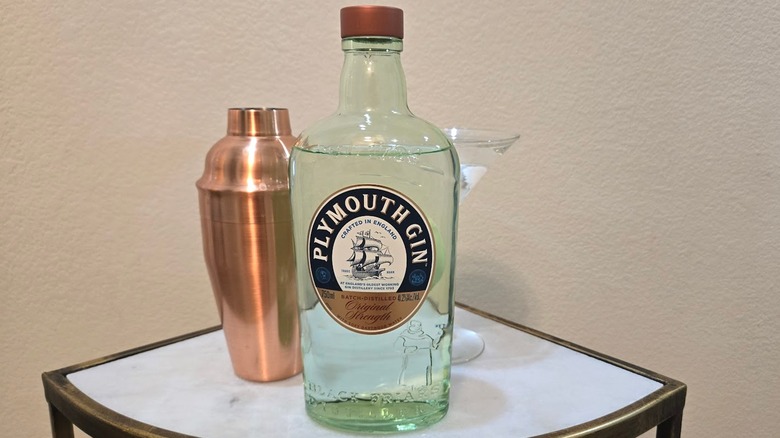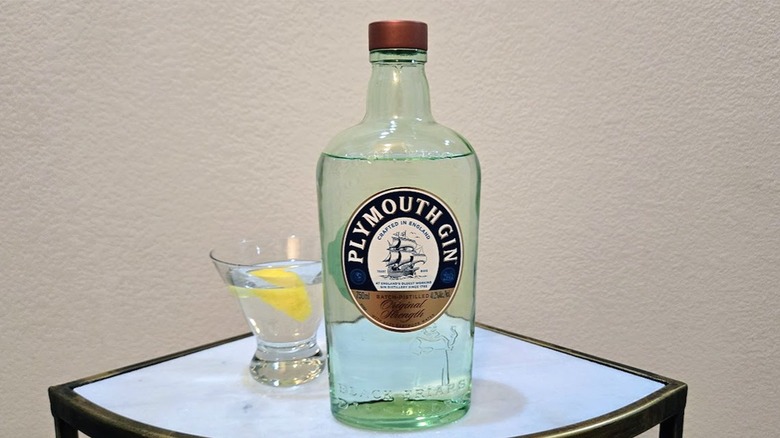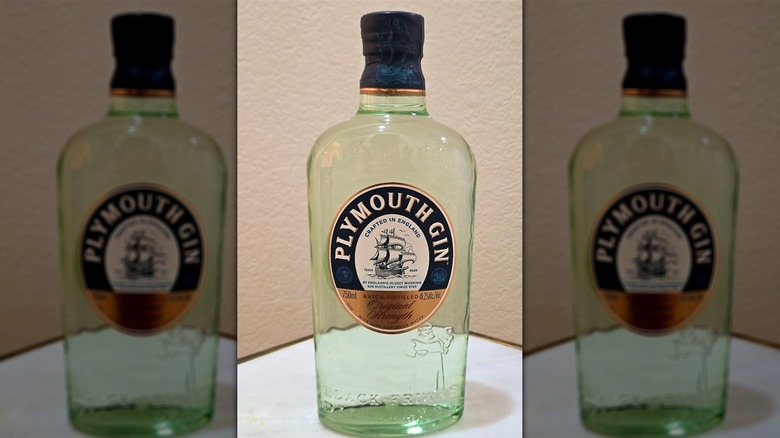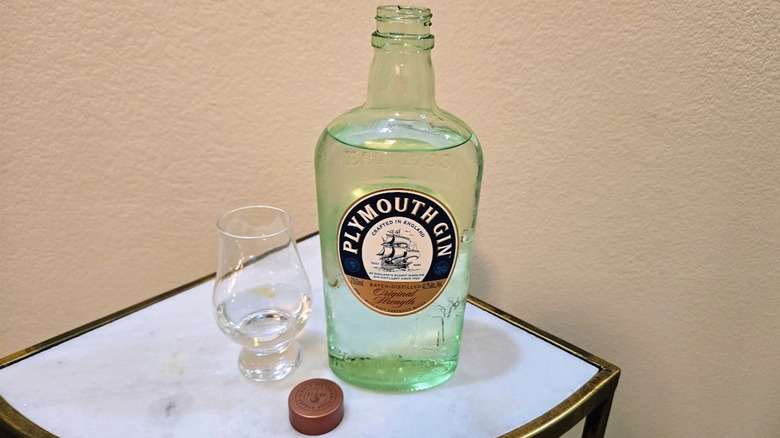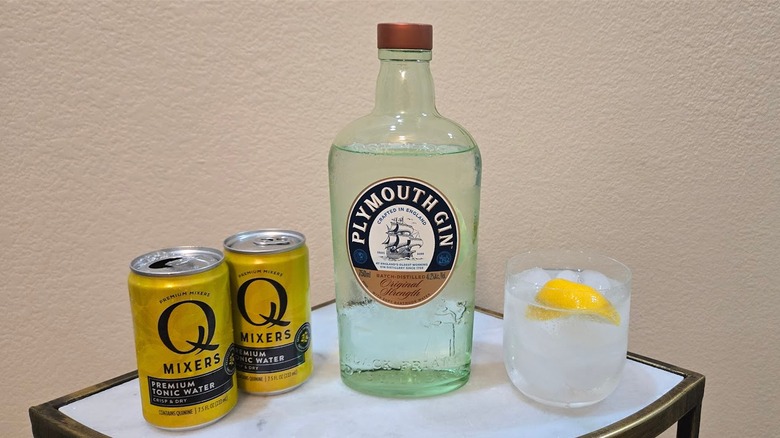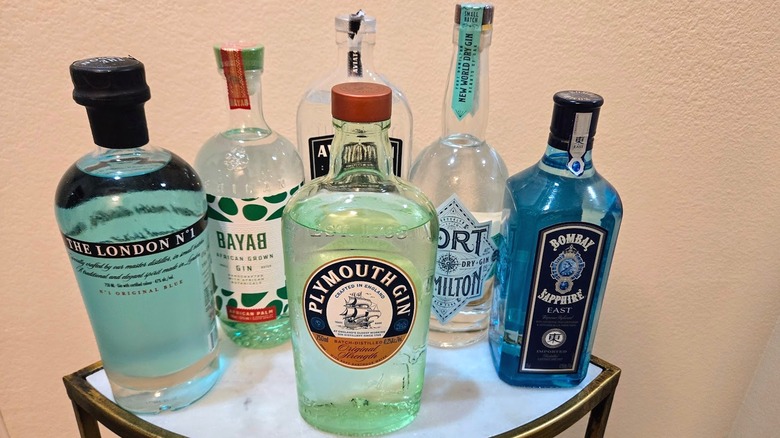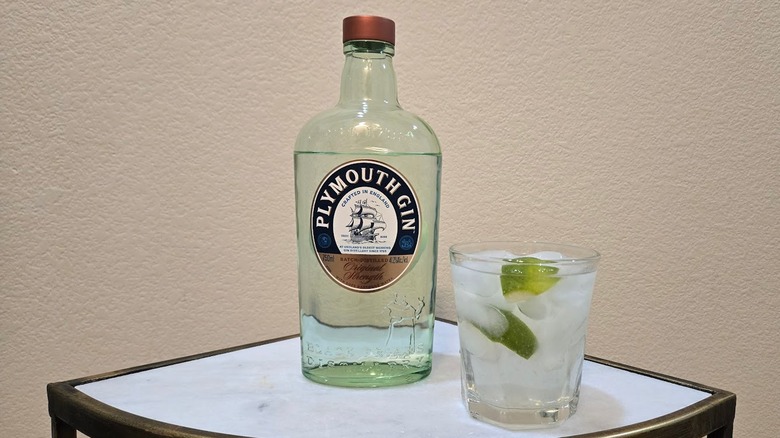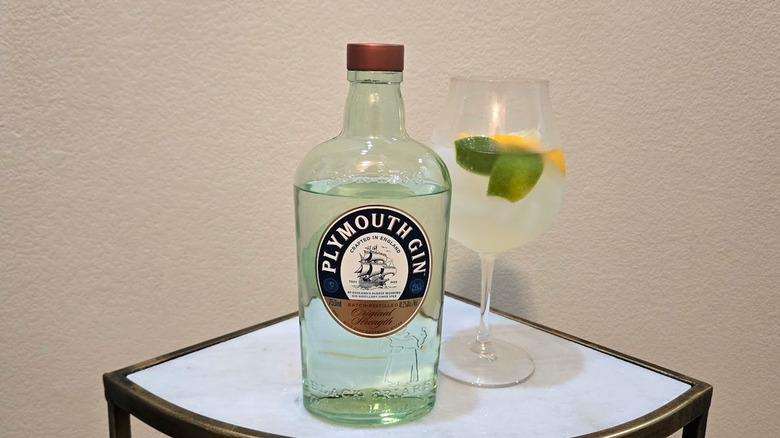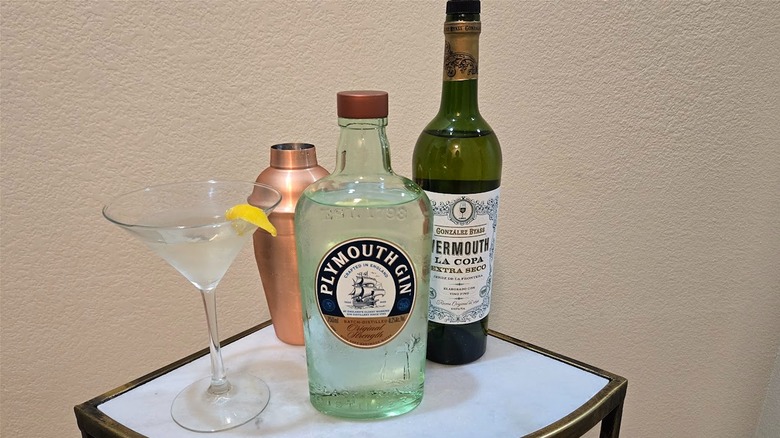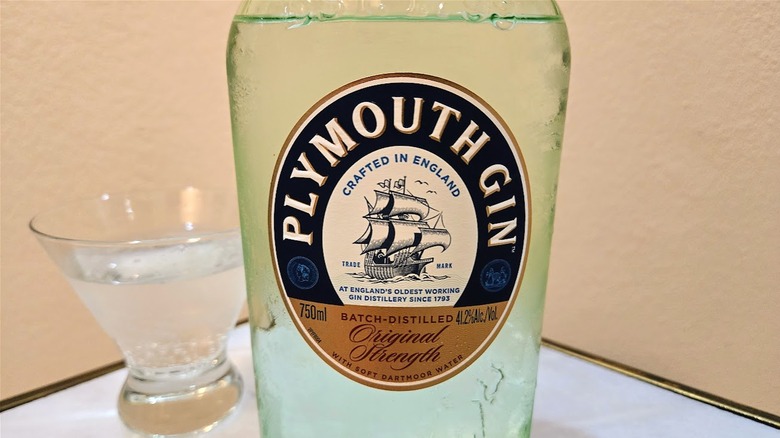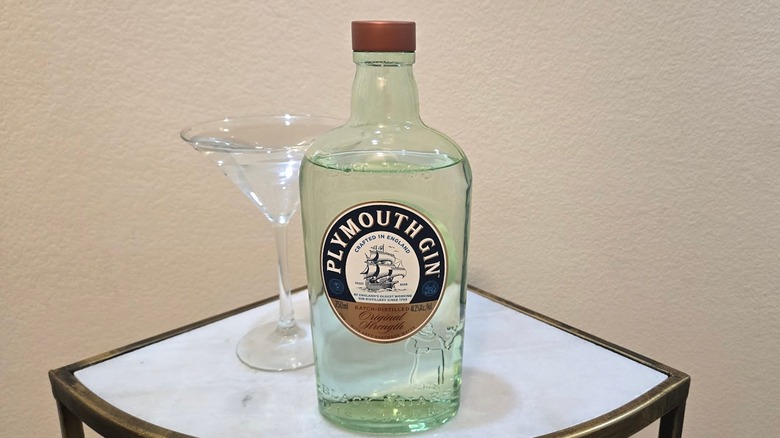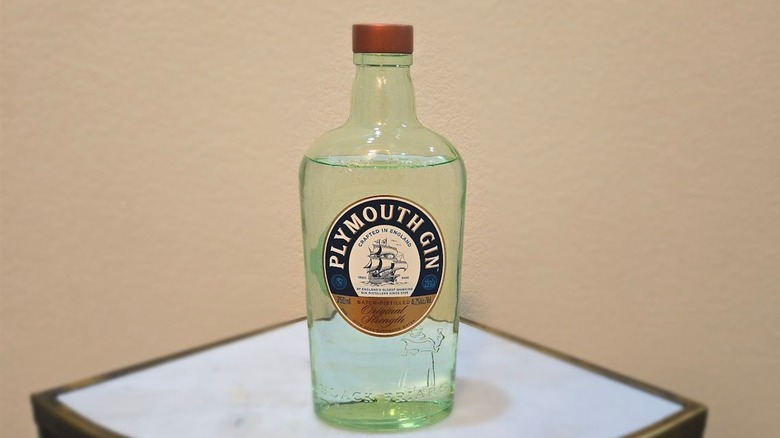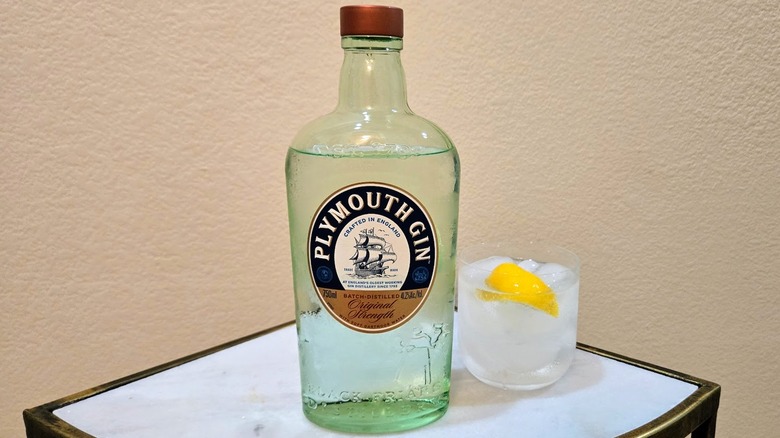Plymouth Gin: The Ultimate Bottle Guide
Gin, the juniper-based clear liquor, is amazing in classic gin cocktails, like the negroni, gimlet, martini, and gin and tonic. The liquor brand considered to be the original dry martini spirit is Plymouth Gin. Bartender Thomas Stuart specifically named the liquor in his 1904 cocktail guidebook, Stuart's "Fancy Drinks and How to Mix Them." Stuart called the drink a Marguerite Cocktail, which was innovative, modern, and dry, unique for the time as sweet cocktails were more in favor. The drink called for two parts Plymouth Gin, one part dry vermouth, and a dash of orange bitters. For its use in the first ever dry martini, the company received the Royal Warrant in 1882
Over the years, the gin has been a favorite of world leaders and celebrities, including Winston Churchill, Alfred Hitchcock, President Franklin D. Roosevelt, and Ian Fleming, who was perhaps enjoying a Plymouth Gin martini when he wrote that James Bond preferred his shaken, not stirred. Considered the single malt of gin due to its character and taste, Plymouth Gin's rich past and ability to maintain a presence as a premium gin with historical significance led us to dive into what makes Plymouth Gin unique.
Some recommendations are based on first-hand impressions of promotional materials and products provided by the manufacturer/distributor/etc.
The history of Plymouth Gin
Plymouth Gin's history begins with its name, Plymouth, the maritime town in Devon, England where it started. The distillery building was home to a malt house as early as 1697, malting cereal grains for alcohol production. However, it took over 100 years for it to become the official home of Plymouth Gin. In 1973, Thomas Coates joined Fox & Williamson Distilling, producing the first bottles of the gin named for the town that same year. The company would take on Coates' name shortly after, becoming Coates & Co.
Since its beginning, the gin has been produced in the historic Black Friars Distillery, a former monastery that Coates & Co. converted and named after the Dominican order of monks known as the Black Friars. Plymouth Gin is the only gin in England still crafted in its original location.
Over the years, Plymouth Gin has had an array of owners, including its Allied Distillers and a management group led by Charles Rolls. While other owners made changes to Plymouth Gin's formula prior to Allied and Rolls ownership, the brand returned to Coates' original recipe while under its Allied Ownership and the original alcohol level during Rolls' tenure, both working with Master Distiller Sean Harrison. Today, Pernod Ricard owns the brand.
How is Plymouth Gin made?
Today, Plymouth Gin uses the secret recipe that Coates first created in 1793. In years past, when gin was not as popular, the company began using a sugar base for the gin, producing a lower alcohol level than today's product. However, when Master Distiller Sean Harrison joined the distillery in the 1990s, the company reverted back to the historic recipe that had made Plymouth Gin a beloved product for gin-drinking generations, returning it to its initial alcohol level of 41.2% alcohol by volume.
The gin's production begins with a neutral grain spirit base that is re-distilled with seven botanicals, including juniper, orris, orange peel, angelica, cardamom, lemon peel, and coriander, of which none are bitter, ensuring the palate is not harsh. The spirit is mixed with soft water from the local Dartmoor reservoir to lower the alcohol to the legal level after distillation.
Though London Dry gins can use various distillation methods, Plymouth Gin is always copper pot batch distilled. Utilizing copper pot batch distillation versus the larger continuous column distillation creates a well-rounded, full-flavored palate with a silky texture. Distillation occurs in a 7000-litre copper pot installed in the distillery in 1855. Each bottle of Plymouth Gin has a copper rim around the top label, a nod to the copper still. The final production step includes the liquor's brief resting in oak casks, helping further soften and round out the palate while adding a hint of creaminess.
What does Plymouth Gin taste like?
While Plymouth Gin is a London Dry gin, it has a soft, subtle, refined character. While juniper is gin's main flavor, Plymouth is not as juniper-forward and pine tree flavor is not as dominant as other options in the category of gins. Instead, Plymouth's dominant flavor is citrus, layering fresh lemon zest, sweet orange, and tangerine, with the cardamom, angelica, and orris root giving a spicy earthiness that melds with herbaceous notes of fresh coriander, peppercorn, and eucalyptus on the back palate. The texture is viscous, with a creamy, well-rounded palate.
The production includes water naturally filtered from the Dartmoor reservoir over granite, adding a subtle mineral note to the liquor. Though the liquor is over 80 proof, it does not have a harsh alcoholic bite. Instead, the gin has lovely balance. Due to its dry style and smooth palate, Plymouth is one of the best gins for beginners, delivering an easy-to-enjoy style of gin.
How to drink Plymouth gin
Plymouth Gin's smooth, approachable palate allows it to be easily enjoyed in cocktails or on its own. As the natural juniper notes are not as powerful as in other London Dry gins, you can easily sip the gin neat to taste the botanicals without overwhelming your palate with the flavor of pine trees. Likewise, chilling the gin or serving it over a single large ice cube is another way to drink gin, as the chill will help diffuse the soft but still ever-present juniper notes.
If cocktails are your preference, Plymouth Gin's style is a versatile ingredient, particularly in cocktails that require few ingredients, letting the aromas and flavors of the botanicals shine. Some of the best drinks to mix with gin include a classic gin and tonic, dry martini, or gimlet. And you will want the most simple garnish for a gimlet or gin and tonic, showcasing the natural flavors of the gin. The main thing to remember is to use quality mixers, like freshly squeezed lime juice and premium tonic water, like those from Q Mixers or Fever Tree, which will enhance the natural citrus flavors of the super-premium gin. If a dry martini is your choice, we suggest garnishing it with a twist to bring out the lemon in the gin.
How does Plymouth Gin compare to other London Dry gins?
It is not easy to compare Plymouth Gin to any other style of gin as it is in a category of its own. However, in the sea of options ranging from other London Dry gins to modern New World and New America gins, which are all made dry in style from juniper with an infusion of botanicals, Plymouth outshines many of its competitors due to its softer style without the overriding pine resin characteristics, giving it versatility.
The 41.2% alcohol by volume is lower than many other London Dry gins, particularly classic products like Tanqueray, which has an ABV of 47.3%, or modern options, like the 95.2 Proof NOLET's Silver Gin. Plymouth's smooth palate lacks the bite that overwhelming juniper-forward flavor and high alcohol of some London Dry gins. Instead, it provides a soft style without added flavorings, colorings, sugars, or sweeteners, making it ideal to include in spirit-forward cocktails where the liquor is the star, like a dry martini.
Is Plymouth Gin good value for money?
Plymouth Gin prides itself on being an artisanal, hand-crafted product with great history. The focus is on quality and authenticity, creating single-batch liquors with well-defined character. The company does this while making noteworthy efforts to work in a sustainable manner, producing each 750-milliliter bottle of Plymouth for around $34.
As a super-premium gin product, its price is a few dollars higher than that of some large production London Dry gins, like Tanqueray, Beefeater, and Bombay Sapphire. However, its price is on par with other super-premium, modern products, like NOLET's, London No.1, and Hendrick's. The main difference that sets Plymouth apart, making it worth the price, is its 200+-year-old history. The first bottles of Tanqueray arrived in 1830. Likewise, bottles of Beefeater came over 100 years after Plymouth in 1876. Bombay Sapphire didn't make its debut until 1960. While more modern gins did not arrive on the scene until the past few decades.
Plymouth Gin is both a brand and a style
As we have noted, Plymouth Gin is a London Dry gin. However, it also falls into an additional category as a Plymouth-style gin. Where London Dry can include a wide array of fruits, herbs, and other ingredients in its infusion, Plymouth Gin uses a specific mix of botanicals. The mix has remained the same since Thomas Coates produced the first bottles in 1793. This combination produces softer piney herbal flavors with more citrus and earthy notes.
Another essential element of Plymouth gin is that the production of Plymouth must be within the town of Plymouth, England. The fact that Plymouth Gin has been made in the same distillery within Plymouth for centuries is part of its historical significance. Plymouth Gin once had European Union Protected Geographical Indication (PGI) status, noting that all Plymouth Gin must happen within the designated area of Plymouth, similar to how Champagne can only come from Champagne, France. The company chose to let the PGI status expire when the European Union required Plymouth Gin to share its recipe to maintain the PGI status. Pernod Ricard allowed the designation to lapse rather than give away its proprietary recipe.
Plymouth Gin has been a bartender favorite for years
Thanks to its smooth and soft flavor profile, with less piney juniper notes found in other London Dry gins, Plymouth has been the key ingredient in gin cocktails for generations. When bartending legend Harry Craddock published the infamous "The Savory Cocktail Guide" in 1930, 34 of his cocktails called for Plymouth Gin specifically, more than any other gin in the book, including the traditional gimlet, Bijou cocktail, and pink gin. Craddock's guidebook has become one of the most influential works for novice cocktail enthusiasts and tenured mixologists, detailing the artistry and craftsmanship of cocktail creation.
In addition to Thomas Stuart's and Harry Craddock's cocktail guidebooks, Plymouth Gin was the liquor of choice for gin cocktails in "The Waldorf Astoria Bar Book" and Harry Johnson's "New and Improved Bartender's Manual." While Plymouth Gin went through several years of struggling sales with various corporate owners changing its formula. Today, the original version remains one of the finest gins in the world, particularly for dry martini lovers.
The Plymouth Gin distillery was once a monastery, prison, and meeting hall
The distillery building dates to between 1425 and 1431. The Refectory room, with a hull-shaped timber roof, was built in 1431 and still intact. Today, it is considered a protected national monument with great historical significance as it is one of the oldest buildings in Plymouth, which is also the oldest working gin distillery in England.
While it was originally the Black Friars Monastery, after King Henry VIII dissolved the Catholic Church to establish the Church of England, it became a debtors' prison. An engraving of a monk is on the back of Plymouth's bottle, a nod to the Black Friars who once inhabited the distillery. There was a saying once that when the monk's feet became dry, it was time to get another bottle.
With its location not far from the harbor, in 1620, the building was used as a meeting hall for the town and where the Pilgrim Fathers spent their last night before setting sail for the New World on the Mayflower. Each bottle of Plymouth Gin features a picture of the momentous boat front and center on the label.
Plymouth Gin is dedicated to sustainability
Over the years, Plymouth Gin has changed its bottle design numerous times. The best design yet came in 2021 when the company introduced its lighter glass bottle, saving carbon emissions. The production of glass is one of the largest emitters of greenhouse gases. Reducing the weight of the bottles helps lower the emission levels of greenhouse gases in production and the product's carbon footprint during transport.
The company also stopped using all single-use plastics, making 100% of the Plymouth gin bottle recyclable. This step is an additional step element of its sustainability efforts, which also include working entirely with renewable energy. Making a nod to its historical ties to the ocean and the importance of water, particularly its soft Dartmoor water, the company donates an English pound for each sea-green bottle sold to help clean the oceans working with Ocean Conservation Trust. Additionally, each bottle includes the website (responsibility.org) to promote responsible drinking and end underage alcohol consumption and driving under the influence.
The city and its gin have strong ties to the British Royal Navy
Plymouth is a seaside port town that is home to the British Royal Navy. Plymouth Gin has had long-established ties to the maritime military, as doctors believed that the botanical-infused spirit could help with medicinal needs while at sea, preventing scurvy or malaria. Commissioning kits on new ships departing from Plymouth would stock Plymouth Navy Strength Gin, and it became a favorite drink for the naval officers. For nearly 200 years, every ship departed port with barrels of Plymouth Gin.
Though known at the time only as the higher alcohol style of Plymouth Gin, as the introduction of Navy Strength Gin did not occur until 1998, the gin has a higher alcohol level of 57% ABV. The ABV of all Navy Strength alcohol is higher than the standard strength as its storage on boats was near the gunpowder. If the liquor accidentally leaked into the gunpowder, the powder would still ignite. On the other hand, if a traditional spirit with a lower alcohol strength leaked into the gunpowder, the powder would be ruined. Of course, at 57% ABV, the liquid is flammable, so if the gin somehow caught on fire, the whole boat could have blown.
You can book a tour with Plymouth Gin's Master Distiller
Sean Harrison is more than just the Master Distiller at Plymouth Gin. He is also a former Lieutenant in the Royal Navy. It is quite apropos that Harrison now runs the distillery associated with the British Royal Navy for so many years.
When he joined Plymouth Gin as Assistant Manager, he had much to learn about the liquor business. His education in the industry moved quickly. Shortly after taking the position, Plymouth Gin's then Distillery Manager Desmond Payne moved on to a sister brand at the time, Beefeater. Payne continued mentoring Harrison, helping him rebuild the historic product, and returning to the original recipe. He shares his background story with visitors to the distillery in a one-on-one tour of the historic property.
While a general tour of the Black Friars Distillery costs 15 English pounds, your meeting with Harrison will set you back 195 English pounds. However, you will enjoy cocktails with Harrison and a local fish and chips meal. After touring the Barbican streets of Plymouth, Harrison will lead you on a guided tour of the distillery, where you will have a chance to make your own bottle of Plymouth Gin.
